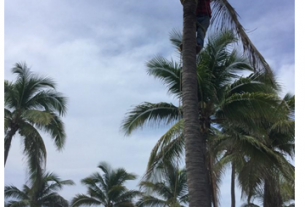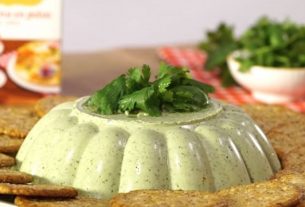By Tommy Clarkson on the August 2020 Edition
Angel Wing Begonia Begonia Hybrid
Family Begoniaceae
Also known as Cane Begonia
(If ever there were a contest to find the most lop-sided leaves on a plant, this might well be a good contender. However, this uniqueness notwithstanding, with delicate, year-round “flowers” of red, pink or white, it has some delightful features!)
But, let’s first, briefly, discuss the Begoniaceae family. As some psychologist must have surely said, “To know the family, and from whence one came, is to better understand the individual.”
 (Gee, that sounds rather profound!) Well, Begoniaceae is comprised of two genera of tropical perennial herbs that range from shrubs to climbers. All told, there are somewhere between 900 to, perhaps, 2000 species makes for huge reunions! Striving, in their own way, to be botanically, politically correct, their flowers are usually unisexual. . . and if that whole issue confuses you, welcome to my world!
(Gee, that sounds rather profound!) Well, Begoniaceae is comprised of two genera of tropical perennial herbs that range from shrubs to climbers. All told, there are somewhere between 900 to, perhaps, 2000 species makes for huge reunions! Striving, in their own way, to be botanically, politically correct, their flowers are usually unisexual. . . and if that whole issue confuses you, welcome to my world!
In a bit of “scientific talk,” Kirsten Albrecht Llamas says in her book “Tropical Flowering Plants, A Guide to Identification and Cultivation,” their leaves are “subotbiculsar to obliquely ovate,often with zones of dark red, pink, and green, (with) colored veins, often covered with glistening scales and/or hairs’ margins sometimes fringed (fimbriate), (with the stems) covered with hairs.” No, this will not be on the test!
Nellie Neal, another smart lady, wrote about the “wings” of this somewhat different appearing plant in her fun book, “Gardener’s Guide to Tropical Plants.” She said that, appropriate to its name, “The leaves are wing-shaped, sometimes elongated, almost ridiculously, to climax in deep points. The rounded leaf top edges are elegantly draped, sometimes cupped or serrated along the edges, and often splattered with accent colors.
They look slightly bizarre but effortlessly charming (with) many shades of green but also bronze and shades of red spread warmly on the undersides. . . each inflorescent has a pendant shaped bract that opens up like a locket to reveal tiny white flowers. ”
There are some who assert that the Angel Wing Begonia was first hybridized in Brazil. Other sources state such was initially done by California plant breeder Eva Kenworthy Gray in 1926. I suspect one or the other if not both accomplished this with a cross between Begonia aconitifolia and B. coccinea. However, the hybrids take on an array of different appearances. Some leaves are spotted, some not. But, a rather interesting aspect of these is that, with a sweet, tart taste, the “flowers” are edible!
 Whatever its genesis, they prefer to grow in a shady to partially shading locale outdoors or in a bright, humid, indoor location.
Whatever its genesis, they prefer to grow in a shady to partially shading locale outdoors or in a bright, humid, indoor location.
Out, surrounded by nature, Angel Wing Begonias like filtered/ dappled shade and will well enjoy early morning or late after-noon sun. Of the “sensitive sort,” they will burn if grown in direct mid day sun.
We’ve one hanging in a coconut fiber (coir or fibre de coco) basket on the northeast side of our dining palapa. In plant “adulthood,” they may reach one to four feet (30 cm – 1.22 meters) in both height and width. Despising drought during which its cane will collapse it requires regular watering and wants a good dose of balanced fertilizer regularly. Otherwise, this lovely hybridized species is easy to grow in richly organic, well-drained soil. Those clusters of flowers are at the end of its leaf axils (The upper angle at which a leaf joins its stem) on waxy stems. These are found to be tasty by mealybugs and aphids so watch for them.
 There are a couple of ways to propagate these both from stem or tip cuttings. The first is the simplest. Merely place a stem with two or three leaves into water and ask it nicely to please root. The second is only slightly more complicated. First, cut a two-leaf section of the stem four to six inches (10.16-15.24 cm) from the end; peel off the lower leaves; dip the lower stem end in rooting powder; insert about two inches (5.1 cm) into potting soil; and finally moisten the entirety of the soil. In about a week, pull gently on your plant and if it holds, it has rooted. At this point you may wish to move it to a larger, regular pot.
There are a couple of ways to propagate these both from stem or tip cuttings. The first is the simplest. Merely place a stem with two or three leaves into water and ask it nicely to please root. The second is only slightly more complicated. First, cut a two-leaf section of the stem four to six inches (10.16-15.24 cm) from the end; peel off the lower leaves; dip the lower stem end in rooting powder; insert about two inches (5.1 cm) into potting soil; and finally moisten the entirety of the soil. In about a week, pull gently on your plant and if it holds, it has rooted. At this point you may wish to move it to a larger, regular pot.
We have three specimens. Two appear to be identical except the one in the palapa presents itself as a vine, while another, further down in the gardens, has decided it would rather be a bush! I suppose every family has one or two within it that just wish to be different!
—
Tommy Clarkson is a bit of a renaissance man. He’s lived and worked in locales as disparate as the 1.2 square mile island of Kwajalein to war-torn Iraq, from aboard he and Patty’s boat berthed out of Sea Bright, NJ to Thailand, Germany, Hawaii and Viet Nam; He’s taught classes and courses on creative writing and mass communications from the elementary grades to graduate level; He’s spoken to a wide array of meetings, conferences and assemblages on topics as varied as Buddhism, strategic marketing and tropical plants; In the latter category he and Patty’s recently book, “The Civilized Jungle” – written for the lay gardener – has been heralded as “the best tropical plant book in the last ten years”; And, according to Trip Advisor, their spectacular tropical creation – Ola Brisa Gardens – is the “Number One Tour destination in Manzanillo”.



